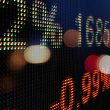by Jurrien Timmer, Director of Global Macro, Fidelity Investments
Key takeaways
- Inflation can turn into a bigger threat when it becomes psychological, with businesses and workers demanding ever-higher prices and wages.
- This risk can be better understood by looking at longer-term inflation expectations, which have been stable thus far but could be starting to increase.
- The market is now expecting a faster pace and greater magnitude of rate hikes than it was just months ago. This is pressuring stock prices.
- One reassuring factor is that earnings growth and growth expectations for this year have continued to surprise on the upside.
The sense of urgency in the markets over inflation is becoming palpable. With each passing day, it seems that investors and the Fed are increasingly wondering whether inflation—and expectations for the pace of future inflation—will start to run away, such that it becomes difficult for the Fed to effectively hit the brakes.
Inflationary shocks usually stem from some kind of shock in the world and the economy, like from supply-chain bottlenecks or sanctions (which constrain the supply of certain goods, sending prices higher).
The risk is that inflation becomes psychological, with companies and people expecting increasingly higher prices in the future. When that happens, businesses and workers start demanding higher prices and wages, just in case inflation persists. And that very process can feed on itself, creating spiraling inflation.
The Fed knows this, which is why it needs to slow inflation, and inflation expectations, swiftly. The Fed is powerless to resolve the supply side of the inflation problem—it can't relieve shortages caused by global shipping problems, the pandemic, or war. It has to focus instead on demand destruction—on raising interest rates so that people and businesses buy less goods and services. Slowing demand will hopefully slow inflation, but the Fed needs to do it quickly and forcefully to prevent inflation expectations from adding fuel to the fire. (Learn more about protecting your money from inflation.)
Thus far, while short-term inflation expectations have risen substantially, longer-term inflation expectations (which may be more indicative of the risks of spiraling inflation expectations) have remained pretty stable. But judging by longer-term future expected inflation rates, as implied by yields on Treasury Inflation-Protected Securities (TIPS), this may be changing.
Of course, the Fed is surely taking note of all of this. Just 6 months ago, it appeared that the Fed's strategy would be a gradual pace of hikes, eventually reaching a fed funds rate of 2.5% (a level that would be neither accommodative nor restrictive). Now, however, the market expects the fed funds rate to climb another 3 percentage points over the next year. Below we see the forward curve—indicating investor expectations for future interest rates—as of 6 months ago (orange) compared to last week (green).
The market is now pricing in 10 more 0.25 percentage-point hikes this year, with only 8 more months left in the year. So it doesn't seem unreasonable to potentially expect several successive 0.50 percentage-point hikes, starting with the May Federal Open Market Committee meeting.
Rates have already been rising in the bond market. In my view, the bond market has already priced in all the Fed's incremental moves for this year, which makes the exact timing and magnitude of the next few hikes somewhat moot. Whether the Fed does 0.25 or 0.50 percentage points at a time is not as important as where we end up—meaning, how high the Fed ultimately goes by the end of this rate-hike cycle. Yields have already risen at various maturities along the Treasury yield curve. A lot has been priced in, but the question is whether it's enough.
Further valuation declines ahead
For the Fed to destroy demand, it needs to tighten financial conditions by raising the cost of capital. The fact that stock prices are under pressure shows that it is achieving this.
For stocks, you can estimate the cost of capital using a discounted cash flow model. The cost of capital can increase as stock prices decline, expected future cash flows from stocks increase, or both. While the cost of capital has been increasing since the start of the year, in my view this process is not yet complete.
To be sure, stock valuations as measured by price-earnings (P/E) ratios have already declined significantly. For the S&P 500®, the trailing P/E ratio (meaning, based on the previous 12 months of earnings) has now fallen 8.5 points since a year ago. And the forward P/E ratio (meaning, based on estimated earnings for the next 12 months), has compressed 5 points.
While this valuation decline is significant, it still may not be enough. Based on relationships between P/E ratios and bond yields, by my estimates, the forward P/E for the S&P should be closer to 15. That suggests another 3 points of decline from here.
All eyes on earnings
Whether a further P/E decline affects stock prices may depend on earnings growth. Price is at the intersection of valuation and earnings, after all.
The good news is that earnings are expected to grow 10.9% this year, and that number has been rising. With first-quarter earnings season now in full swing, companies are mostly delivering. Out of the first 98 companies that reported earnings, 79% beat analyst estimates.
Are we oversold yet?
While stocks have become more volatile again in the last week—with growth and particularly small-cap growth leading the downside—the market does not seem that oversold yet on a technical basis. The chart below shows a de-trended Bollinger Band, which is a way of understanding when the market trades unusually high or low relative to its own recent price movements. Currently, we're in the middle of the range.
All in all, while some sentiment surveys are starting to give me those contrarian vibes, for the most part the market does not seem oversold yet. The best hope for the bulls is that earnings continue to surprise to the upside, thereby offsetting most of the valuation decline.
That, or the pace of inflation—and expected inflation—starts to slow, which would mean fewer rate hikes might be necessary. That would take tremendous pressure off of equity valuations. But so far, the opposite is happening.
About the expert

Jurrien Timmer is the director of global macro in Fidelity's Global Asset Allocation Division, specializing in global macro strategy and active asset allocation. He joined Fidelity in 1995 as a technical research analyst.
Copyright © Fidelity Investments












